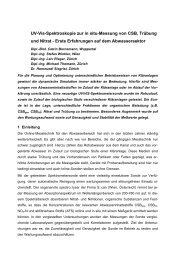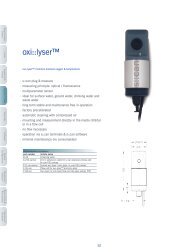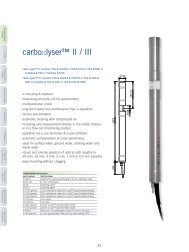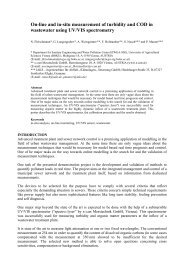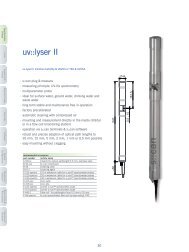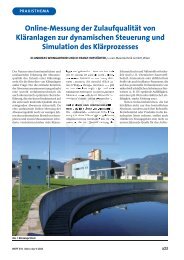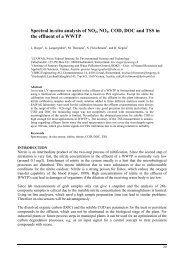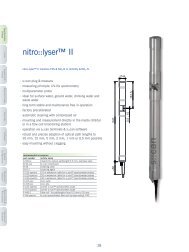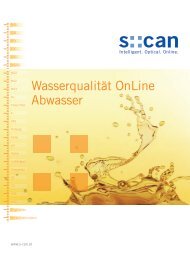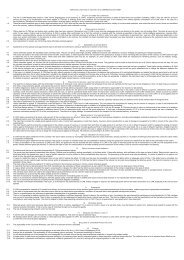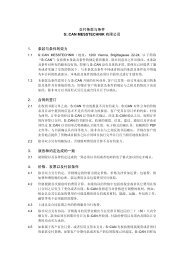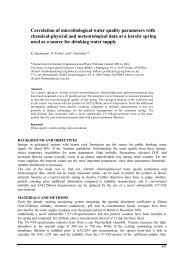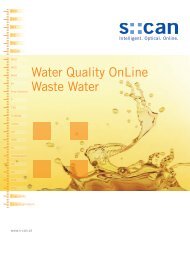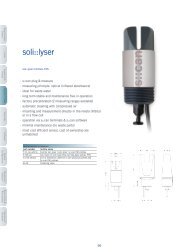Water Quality OnLine Drinking Water - S-can
Water Quality OnLine Drinking Water - S-can
Water Quality OnLine Drinking Water - S-can
Create successful ePaper yourself
Turn your PDF publications into a flip-book with our unique Google optimized e-Paper software.
NO 3-N<br />
The s::<strong>can</strong> solution<br />
Absorbance [Abs/m]<br />
500 120<br />
450<br />
400<br />
350<br />
300<br />
250<br />
NO2<br />
200 NO3<br />
150<br />
100<br />
UV radiation Visible radiation (Vis)<br />
COD_total<br />
BOD<br />
TOC<br />
Benzene<br />
Toluene<br />
Xylene<br />
Phenol<br />
50<br />
0<br />
DOC<br />
COD_dissolved<br />
200 250 300 350<br />
Depending on the method, a spectral probe measures the nitrate<br />
concentration with much greater accuracy and stability and greater<br />
freedom from cross-sensitivities than a simple photometric probe<br />
(see diagram below). So an s::<strong>can</strong> spectral probe, regardless of<br />
whether it is a nitro::lyser, multi::lyser or spectro::lyser, is<br />
already widely used as a reference for simple photometric or ISE<br />
probes.<br />
The nitrate value is accurately measured and displayed by s::<strong>can</strong><br />
spectral probes in many applications without calibration. The detection<br />
limit in some applications is in the region of 0.005 mg/l<br />
(!) and even in a heavily loaded SBR reactor at 15 g/l TS, it is still<br />
better than 0.2 mg/l. The recommended measurement path length<br />
for the latter highly concentrated waste water is just 0.5 mm and,<br />
despite this, accurate measurements are possible, as is reliable<br />
cleaning of the measurement gap.<br />
The nitrate value measured by s::<strong>can</strong> spectral probes is extremely<br />
stable in respect to matrix fl uctuations. Thus, for instance, an accurate<br />
nitrate value <strong>can</strong> be measured with one and the same instrument<br />
in most fl ows without local calibration and this is not<br />
disturbed by typical daily, weekly or seasonal fl uctuations either.<br />
The higher purchase price compared with ISE probes will pay for<br />
itself in no more than one or two years of operation, and the many<br />
subsequent years of operation are characterised by problem-free,<br />
practically free-of-charge measurement, free of worries.<br />
You will soon no longer think about the nitro::lyser at all, while<br />
the measurement values, on the other hand, will become the basis<br />
of your day-to-day work which you take for granted.<br />
Spectrometric Photometric ISE<br />
Accuracy ����� ��� ��<br />
Stability (drift) ���� ��� �<br />
Calibration effort ����� ��� �<br />
Maintenance effort ����� ���� ���<br />
Purchase costs �� ��� ���<br />
Operating costs ����� ���� �<br />
Non-compensated spectrum; represents the<br />
dissolved and non-dissolved substances<br />
Turbidity, TSS (total dissolved solids), etc.<br />
colour Turbidity-compensated spectrum;<br />
represents the dissolved components only<br />
0<br />
400 450 500 550 600 650 700 750<br />
Wavelength [nm]<br />
s::<strong>can</strong> measuring method – “Fingerprint“<br />
Comparison of various methods for monitoring NO 3 -N<br />
Conventional solutions<br />
Nitrate is hardly ever measured these days with cabinet analysers<br />
since these also create disadvantages (hydraulic sampling, reagent<br />
consumption, maintenance effort etc.) and, in any case, recognised<br />
alternative methods exist.<br />
Optical probes have been successful and have found acceptance<br />
globally, so today there is generally no longer any real reason to use<br />
a cabinet analyser for monitoring of nitrate.<br />
Ion-selective (ISE) probes have also recently experienced a renaissance<br />
in nitrate measurement based on the lower purchase prices.<br />
However, by contrast with ammonium, the nitrate membranes<br />
available today are not so practical in use because they require<br />
more maintenance and are subject to more drift, re-calibration,<br />
and exchanges. In any event, today the ISE method is not suitable<br />
for WWTP compliance monitoring or even NO3 monitoring in<br />
fresh waters because it is subject to strong drift especially visible<br />
at lower concentration levels. However, ISE probes are increasingly<br />
being offered as an alternative to control nutrient removal<br />
processes, often in combination with ammonium. The capital purchase<br />
price advantage compared with optical probes is striking<br />
only for a very short period. After just two years of operation the<br />
advantage is already lost because of the cost of consumables, and<br />
efforts required for calibration and electrode changing. After 10<br />
years of operation, an ISE probe will have cost about two to three<br />
times as much in total as an optical probe, considering the total of<br />
maintenance hours and consumables.<br />
12<br />
100<br />
80<br />
60<br />
40<br />
20<br />
© s::<strong>can</strong> Messtechnik GmbH



